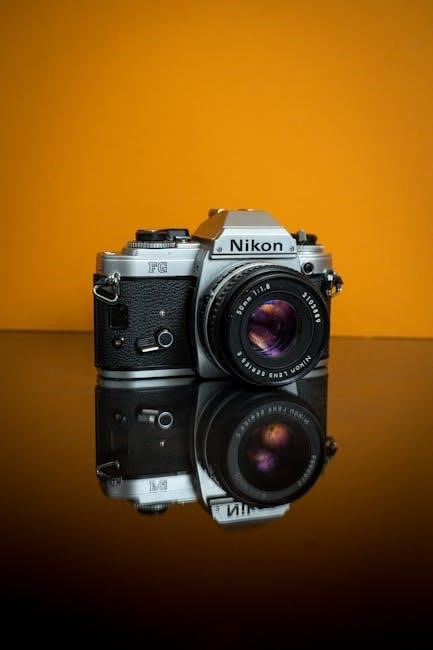Welcome to the Nikon D80 user manual. This guide helps you master the features, settings, and capabilities of your digital SLR camera for stunning photography results.

Camera Features and Specifications
The Nikon D80 offers a 10.2MP APS-C sensor, optical viewfinder with 95% scene coverage, and a hotshoe for dedicated flashguns, supporting both auto and manual modes effectively.
2.1 Key Features
The Nikon D80 boasts a 10.2-megapixel APS-C sensor, delivering exceptional image quality with vibrant colors and sharp details. It features a high-speed EXPEED image processing engine, ensuring quick operation and efficient noise reduction. The camera includes a 2.5-inch LCD monitor for previewing and reviewing images, along with an optical viewfinder offering 95% scene coverage for precise framing. The D80 supports a wide range of interchangeable Nikon lenses, including AF-S, AF, and AI lenses, offering flexibility for various shooting scenarios. Additionally, it has a built-in flash and a hotshoe for external flash units, enhancing low-light photography capabilities. The camera also features 11 autofocus points for fast and accurate subject tracking, making it ideal for capturing dynamic moments. With its durable design and intuitive controls, the D80 is a versatile tool for both amateur and professional photographers.
2.2 Technical Specifications
The Nikon D80 features a 10.2-megapixel APS-C CMOS sensor, measuring 23.6 x 15.8mm, ensuring high-resolution images with excellent detail. It employs the EXPEED image processing engine for enhanced performance and noise reduction. The camera offers an ISO range of 100 to 1600, extendable to ISO 3200 in HI-1 mode, providing flexibility in various lighting conditions. The shutter speed ranges from 30 seconds to 1/8000th of a second, with a bulb mode for long exposures. Continuous shooting is supported at up to 3 frames per second, capturing up to 23 consecutive NEF (RAW) images or 26 JPEGs. The D80 supports SD and SDHC memory cards, with compatibility for high-speed UHS-I cards. It weighs approximately 585 grams without the battery or lens, making it lightweight yet durable for everyday use. These specifications make the D80 a powerful tool for photographers seeking precision and versatility in their work.
Getting Started
Unbox and set up your Nikon D80, insert the battery and memory card, and familiarize yourself with basic operations to begin capturing high-quality images effortlessly.
3.1 Unboxing and Initial Setup
Upon unboxing your Nikon D80, you’ll find the camera body, rechargeable lithium-ion battery, battery charger, USB cable, AV cable, neck strap, Eyepiece Cap, and user manuals. Ensure all items are included and undamaged.
Insert the battery into the charger and charge it fully before first use. Open the battery compartment on the camera’s base and gently slide the battery into place, ensuring it clicks securely.
Next, install a memory card. Open the card slot on the right side, insert the card with the label facing up, and close the compartment. Format the card in the camera for optimal performance.
Familiarize yourself with the camera’s ergonomics, including the grip, shutter button, and control dials. Adjust the neck strap for comfort and explore the placement of key buttons for easy access.
Power on the camera and follow the on-screen setup prompts to set the language, date, and time. Refer to the user manual for detailed instructions to ensure a smooth initial setup experience.
This process ensures your Nikon D80 is ready for capturing stunning images right out of the box.
3.2 Battery and Memory Cards
The Nikon D80 uses an EN-EL3e rechargeable lithium-ion battery, providing ample power for extended shooting sessions. Always charge the battery using the supplied MH-18a charger, ensuring optimal performance and longevity.
For memory, the D80 supports CF (CompactFlash) cards, including Type I and II, and UDMA-enabled cards for faster data transfer. Use a high-speed card to maximize performance, especially when shooting in continuous modes.
Insert the CF card into the slot on the camera’s right side, ensuring it clicks into place. Format the card in-camera to prepare it for use and avoid data corruption.
Keep spare batteries and cards handy, especially during extended shoots or travel. Regularly clean the battery terminals and card contacts to maintain reliable connections.
Properly managing your battery and memory cards ensures uninterrupted photography and preserves your valuable images.
3.3 Mounting Lenses
The Nikon D80 is compatible with Nikon F-mount lenses, offering flexibility for various shooting needs. To mount a lens, align the lens mount indicator (a white dot) with the camera’s mount indicator (also a white dot).
Gently rotate the lens clockwise until it clicks into place, ensuring it is securely attached. For lenses with an A-M switch, set it to the “A” position for autofocus functionality. If using older manual-focus lenses, switch to “M” for manual operation. Note that some legacy lenses may not support metering.
Once mounted, ensure the lens is properly seated and the camera recognizes it. For zoom lenses, use the zoom ring to adjust focal length. Always handle lenses with care to avoid damage to the mount or glass elements.
After mounting, turn the camera on and check the lens information in the viewfinder or LCD to confirm proper connection. This ensures optimal performance and accurate exposures.
For added protection, consider using a lens hood to prevent flare and physical damage. Always store lenses in a protective case when not in use.
3.4 Basic Camera Setup
After unboxing and assembling your Nikon D80, begin by setting the date, time, and language. These settings are accessed via the menu system. Ensure the camera’s diopter adjustment matches your eyesight for clear viewfinder visibility.
- Set the shooting mode using the mode dial. Auto mode is ideal for beginners, while manual modes offer more control.
- Adjust the monitor brightness and LCD protection settings to suit your preferences.
- Format your memory card to ensure proper functionality and delete any existing data.
- Set your preferred language and time zone for accurate timestamps on images.
These initial steps ensure your camera is personalized and ready for use, providing a seamless photography experience.
Key Components and Controls
The Nikon D80 features a range of essential components and controls designed to enhance your photography experience. The optical viewfinder provides 95% scene coverage and 0.94x magnification, offering a clear view of your subject. The camera’s hotshoe allows for dedicated Nikon flash units, enabling manual or auto flash control. The mode dial on the top offers quick access to shooting modes like Auto, Scene, PASM (Program, Aperture-priority, Shutter-priority, and Manual), and Manual Focus. Other key controls include buttons for ISO adjustment, autofocus modes, and metering patterns. The camera’s ergonomic design ensures intuitive access to these controls, making it easy to adjust settings on the go. Understanding these components is vital for optimizing your camera’s performance and achieving the desired results in various shooting scenarios.
Shooting Modes
The Nikon D80 offers various shooting modes, including Auto Mode for beginners, Scene Modes for specific scenarios, and Manual Mode for advanced control over settings like aperture and shutter speed.
5.1 Auto Mode
Auto Mode on the Nikon D80 is designed for beginners or quick point-and-shoot situations, automatically adjusting settings like aperture, shutter speed, ISO, and white balance for optimal results. This mode simplifies photography by letting the camera handle most controls, ensuring well-exposed images with minimal effort. While Auto Mode limits manual adjustments, it’s ideal for capturing spontaneous moments or when familiarity with advanced settings is limited. The camera prioritizes ease of use, making it accessible for new users. Additionally, Auto Mode works seamlessly with Scene Modes, allowing users to select presets for specific scenarios like portraits, landscapes, or night photography, while still maintaining the convenience of automatic adjustments. This feature bridges the gap between simplicity and creativity, providing a solid foundation for those learning the basics of digital photography.
5.2 Scene Modes
Scene Modes on the Nikon D80 offer preset settings tailored to specific shooting scenarios, such as portraits, landscapes, night portraits, and more. These modes automatically optimize camera settings like aperture, shutter speed, and ISO to suit the selected scene, ensuring optimal results. For instance, Portrait Mode prioritizes a shallow depth of field to blur backgrounds, while Landscape Mode enhances sharpness and color saturation for scenic shots. Night Portrait Mode balances flash with ambient light to capture both subjects and backgrounds effectively. Scene Modes provide users with creative control without requiring manual adjustments, making them ideal for photographers who want to achieve professional-looking results effortlessly. By selecting the appropriate Scene Mode, users can adapt to various shooting conditions and capture high-quality images with minimal effort. This feature enhances versatility and simplifies the photography process for users of all skill levels.
5.3 Manual Mode
Manual Mode on the Nikon D80 grants users full control over camera settings, allowing for precise adjustments to aperture, shutter speed, and ISO. This mode is ideal for experienced photographers who prefer to fine-tune their settings for creative or technical purposes. By switching to Manual Mode, users can override automatic settings to achieve specific effects, such as long exposures for night photography or shallow depth of field in portraits. The camera’s LCD display provides clear feedback, making it easy to monitor and adjust settings. Manual Mode also supports the use of Bulb mode for extended exposures, offering flexibility for unique shooting scenarios. With Manual Mode, photographers can unlock the full potential of the D80, capturing images that reflect their artistic vision and technical expertise. This mode is essential for those seeking advanced control over their photography process.
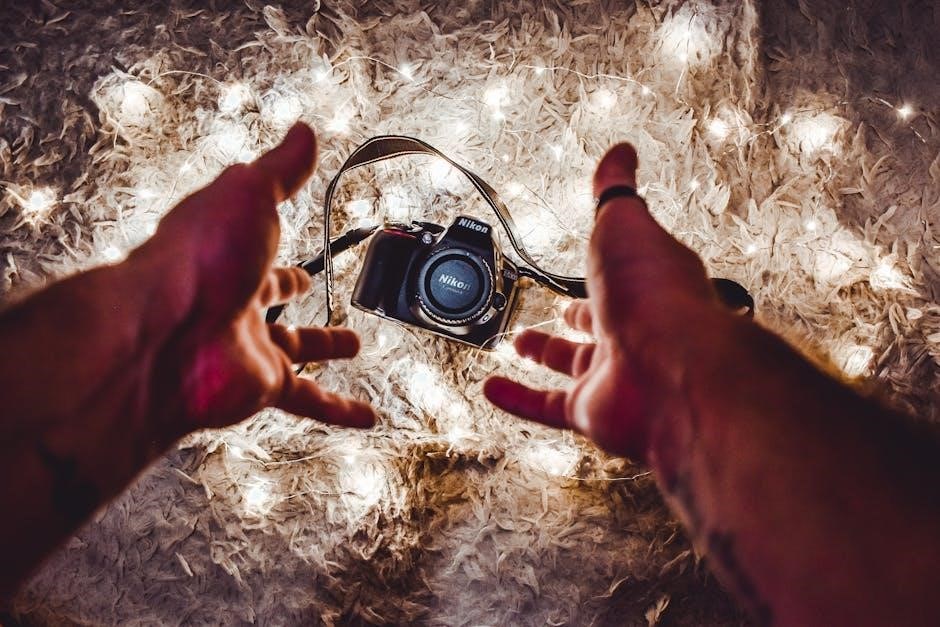
Autofocus and Manual Focus
The Nikon D80 features an advanced autofocus system with 11-area AF sensors, ensuring precise and fast focusing in various lighting conditions. Autofocus can be activated via the shutter release or the AF button, allowing for flexible shooting. For manual focus, the camera offers a smooth focusing ring on compatible lenses, enabling precise control. The A-M switch on Nikon lenses determines whether autofocus or manual focus is active. When using manual focus, the camera’s electronic rangefinder assists by illuminating a focus indicator in the viewfinder. This feature helps achieve accurate focus without relying on autofocus. The D80 also supports older manual lenses, though metering may require manual adjustments. The optical viewfinder provides 95% scene coverage and 0.94x magnification, aiding in precise focus control. This combination of autofocus and manual focus options caters to both convenience and creative control, making the D80 versatile for photographers of all skill levels.

Metering and Exposure Control
The Nikon D80 offers three metering modes: Matrix, Center-Weighted, and Spot metering. Matrix metering analyzes the entire scene for balanced exposure, while Center-Weighted prioritizes the central area of the frame, ideal for portraits. Spot metering measures a small area for precise exposure control in challenging lighting conditions. Exposure compensation allows adjustments of ±5 EV in 1/3 EV increments, providing flexibility for refining exposures. The camera also features Auto-ISO, which automatically adjusts sensitivity based on lighting conditions, with a maximum limit of ISO 1600. Additionally, the AE Lock function enables users to lock exposure settings for a specific part of the scene, ensuring consistent results. These metering and exposure tools empower photographers to achieve their desired results, whether shooting in automatic or manual modes.
White Balance and Color Settings
The Nikon D80 offers precise control over white balance and color settings to ensure accurate and vibrant images. The camera features multiple white balance modes, including Auto, Preset, and custom settings, allowing you to adapt to various lighting conditions. Preset white balance options include Daylight, Incandescent, Fluorescent, and more, while the custom setting enables you to set a specific white balance using a reference object. Additionally, the D80 allows for fine-tuning of color settings, enabling adjustments to hue and saturation for personalized results. The camera also supports Nikon’s Picture Control system, which offers predefined profiles like Standard, Neutral, and Vivid, each with adjustable parameters for sharpening, contrast, and color saturation. These features provide photographers with the flexibility to achieve their desired color palette and ensure consistent results across different shooting scenarios.
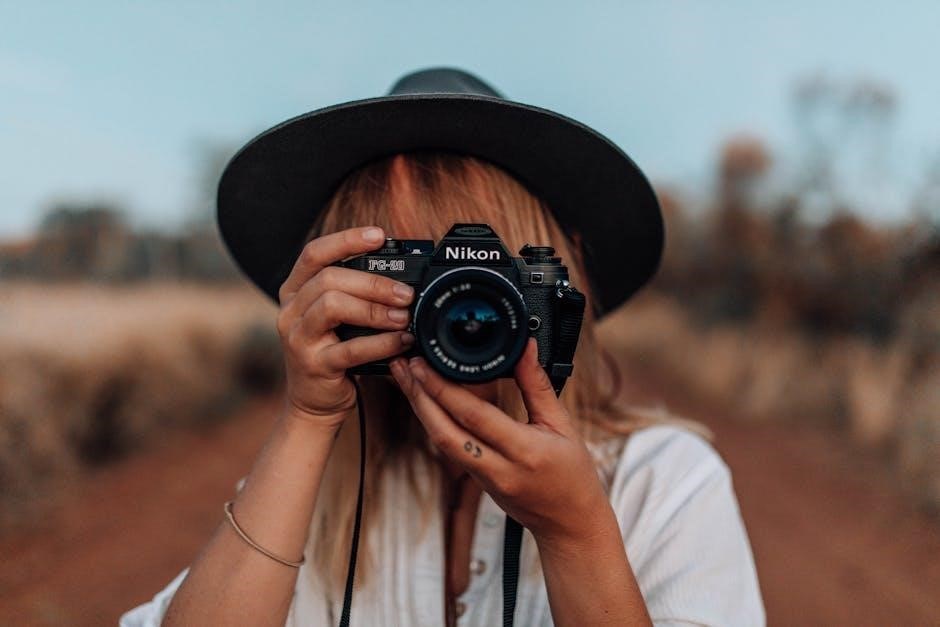
Playback and Editing Features
The Nikon D80 offers a range of playback and editing features to enhance your post-capture experience. The camera’s LCD screen allows you to review images with zoom functionality for detailed analysis. Basic editing functions, such as deleting unwanted photos or protecting favorite images, can be performed directly on the camera. The D80 also supports in-camera image rotation and slide shows for convenient viewing. Additionally, you can transfer images to a computer for further editing using Nikon’s provided software or third-party tools. These features make it easy to manage and enhance your photos without requiring advanced editing skills, ensuring a seamless workflow from capture to post-processing.
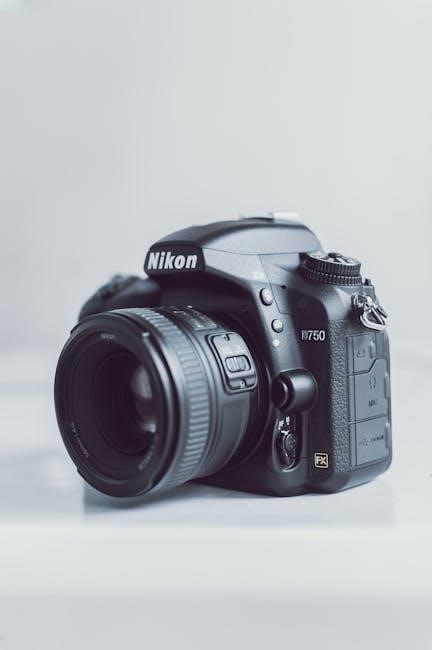
Custom Settings and Personalization
The Nikon D80 allows for extensive customization to suit your photography style. You can personalize settings such as exposure compensation, metering modes, and autofocus preferences. Customizing these options ensures the camera adapts to your shooting habits and creative vision. Use the camera’s menu system to adjust settings like ISO sensitivity, white balance, and image optimization. Additionally, you can save frequently used configurations for quick access. This level of personalization enhances your shooting experience, enabling you to focus on capturing the perfect moment while the camera handles the details. By tailoring the D80 to your preferences, you can achieve consistent and professional results in various photography scenarios.
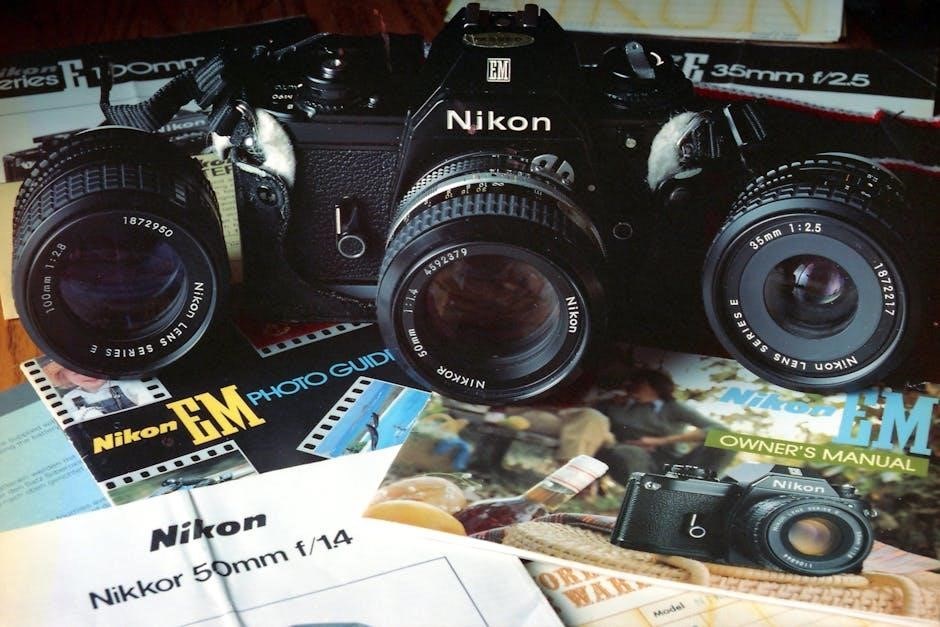
Using Flash
The Nikon D80 features a built-in flash and supports external flash units via its hotshoe. The built-in flash is ideal for fill lighting in bright conditions or low-light situations. For more advanced lighting, attach a Nikon-dedicated Speedlight, which offers manual and auto modes. The camera automatically adjusts flash settings to balance with ambient light for natural results. You can also control flash compensation to fine-tune brightness. When using external flashes, sync speeds of up to 1/200th of a second are supported. The D80’s flash system is versatile, enabling you to achieve professional lighting effects in various photography scenarios.

Maintenance and Care
To ensure optimal performance and longevity of your Nikon D80, regular maintenance is essential. Clean the camera body and lenses with soft, dry cloths, avoiding harsh chemicals. Use a microfiber cloth and lens cleaning solution for the lens surfaces. Protect the LCD monitor with a screen protector and avoid touching it. Store the camera in a cool, dry place, away from direct sunlight and moisture. Use a silica gel packet to prevent humidity damage. For more thorough cleaning, consult a professional. Regularly update firmware to maintain functionality and performance. Always handle the camera and lenses with care to prevent scratches or damage. By following these steps, you can preserve your D80’s quality and extend its lifespan for years of reliable use.
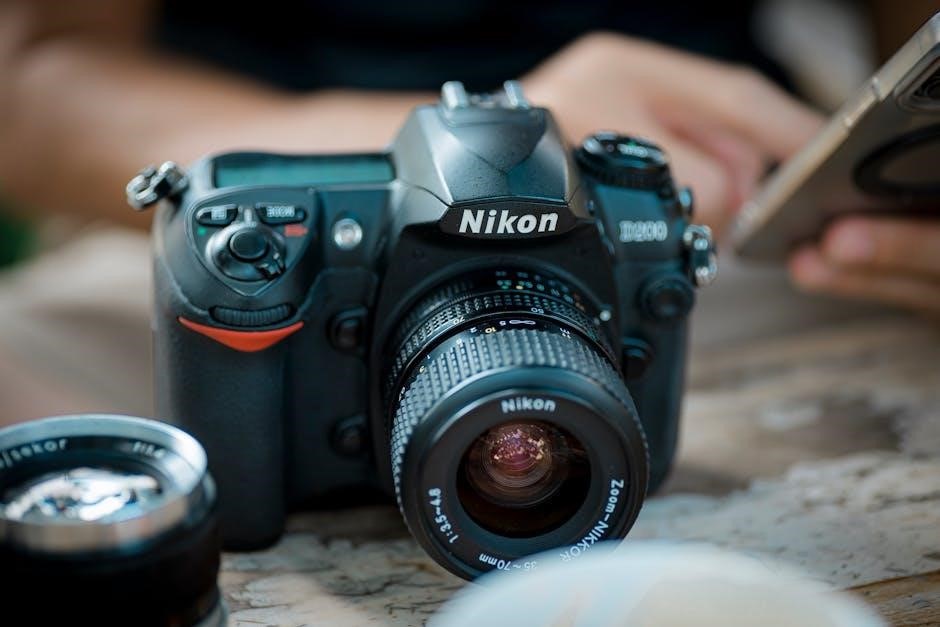
Troubleshooting Common Issues
If you encounter issues with your Nikon D80, start by identifying the problem and consulting this guide for solutions. Common issues include “ERR” messages, which often indicate improper settings or lens incompatibility. If the camera fails to turn on, check the battery level or ensure the memory card is properly inserted. For autofocus problems, clean the lens and sensor, and ensure the AF switch is set correctly. If images appear blurry, verify focus settings or try manual focus. Memory card errors may require formatting the card in the camera. If the LCD monitor is unresponsive, reset the camera or update firmware. For persistent issues, consult the troubleshooting section in the manual or contact Nikon support. Regular maintenance and updates can prevent many common problems, ensuring your D80 operates smoothly.
Glossary of Terms
Understanding key photography terms is essential for mastering your Nikon D80. Aperture: The camera’s aperture refers to the opening that controls light entry, measured in f-stops. Shutter Speed: The duration the shutter remains open, affecting motion capture. ISO: Sensitivity of the camera’s sensor to light, with lower values for bright conditions and higher for low light. Autofocus (AF): A feature that automatically adjusts lens focus for sharp images. Manual Mode: Allows full control over aperture, shutter speed, and ISO. White Balance: Adjusts color settings to match lighting conditions. Hotshoe: A mount for external flash units. Metering: Measures light to determine exposure settings. Bulb Mode: Keeps the shutter open as long as the button is pressed, ideal for long exposures. Familiarizing yourself with these terms will enhance your photography experience with the Nikon D80.

Resources and Support
For comprehensive support and resources, visit Nikon’s official website, where you can download the Nikon D80 user manual, firmware updates, and software. The site also offers tutorials, FAQs, and troubleshooting guides to address common issues; Contact Nikon customer support at (800) NIKON-UX for assistance in the USA, available 24/7. Additionally, online forums and communities provide valuable insights and tips from experienced photographers. Warranty information and repair services are also accessible through Nikon’s support page. Explore these resources to maximize your Nikon D80 experience and resolve any queries efficiently.
